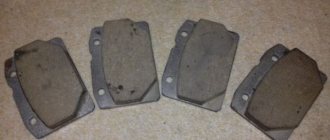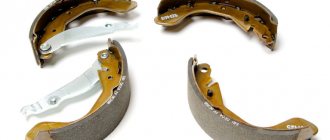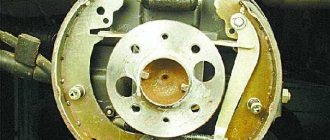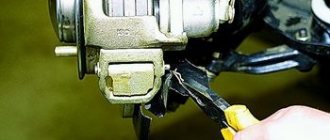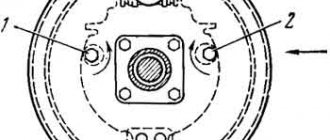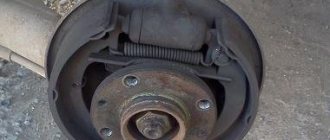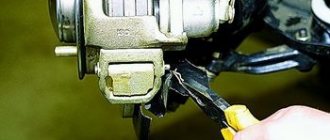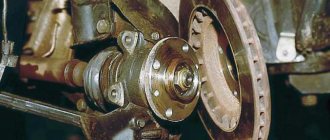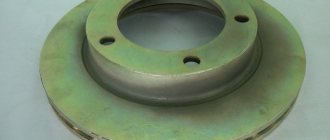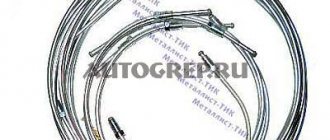The braking system ensures the safety of the car. One of the main components of this system is the brake pads. The braking efficiency depends on their reliability and quality. The pads have a certain service life, so it is necessary to periodically check and replace them.
What are they used for?
When you press the brake pedal, the pressure in the hydraulic system increases and the pads are pressed against the surface of the brake disc or drum. Structurally, a brake pad is a plate on which a lining made of a special material is attached. It contains various components: special rubbers and resins, ceramics, synthetic fibers. The composition may vary depending on the manufacturer. The main requirements that the lining must meet are high wear resistance and the ability to withstand high temperatures, resistance to destruction, but at the same time the material must cause minimal wear of the brake disc.
What are there
The VAZ 2106, like other “classics”, has disc brakes at the front and drum brakes at the rear.
Front brakes
The front end braking system is designed as follows:
- The brake disc is attached to the hub.
- The caliper is fixed to the steering knuckle of the suspension and holds two working cylinders.
- The brake pads are located between the disc and the cylinders.
When you press the brake pedal, the pistons move out of the cylinders, press on the pads and clamp the brake disc together. As a result, the car gradually slows down. The more force is applied to the brake pedal, the harder the pads clamp the disc.
The front brake pads are flat and smaller in size compared to the rear ones.
Rear brakes
Drum brakes on the VAZ 2106 consist of a drum itself, two shoes, a hydraulic cylinder and springs located under the drum. The pad linings are fixed using rivets or adhesive. The lower part of the pads rests against the supports, and the upper part rests against the cylinder pistons. Inside the drum they are tightened by a spring. To allow the wheel to rotate freely when stopping the car is not required, there is a gap between the pads and the drum.
When the driver presses the brake pedal, fluid is pumped into the slave cylinder, causing the pads to spread apart. They rest against the drum, thereby causing the rotation of the wheel to slow down.
Which ones are better
Owners of Zhiguli cars are often faced with the issue of choosing brake pads. The modern auto parts market offers products from different manufacturers. The parts differ in both quality and cost. The following brands of brake pads can be installed on VAZ cars:
- Ferodo (UK). The best products for brake systems that can be found on the automotive aftermarket today. The products are of high quality because they are made from reliable materials.
Prices for brake pads for VAZ 2106 start at 350 rubles. (AvtoVAZ) and reach 1,700 rubles. (ATE).
Adjusting the brakes
To correctly perform operations on adjusting the rear wheel brakes and handbrake , you can use the following recommendations:
- prepare the necessary tools for this case: a 13 mm open-end wrench, pliers, a combination wrench for fastening wheels, a 17 mm socket wrench. and probe 0.1-0.15 mm.
- place the car on an overpass or inspection ditch
- remove the rear wheel caps and loosen the wheel bolts
- raise the rear of the car and install stands
- Unscrew the wheel mounting bolts and remove the wheels.
It should be recalled that performing the described operation is quite inconvenient, since an assistant is required, who must be in the car while checking the brakes and carry out your simple commands.
If such an assistant is found, he, at your command, must press the brake pedal, and at this time, by rotating the drum, you determine whether the pads are in contact with the drum mirror.
If adjustment is required:
- keeping the pads pressed, turn the nut of the adjusting eccentrics 1 and 2 until they come into contact with the pads
- After releasing the brake pedal, turn the nuts in the opposite direction by about 10° so that the gap between the pads and the drum mirror is 0.10 - 0.15 mm.
- use a feeler gauge to check the set gap
- To be more sure, press the brake pedal sharply 3 - 4 times and check the gap again. If necessary, the adjustment should be repeated
- install the wheels, tighten their mounting bolts and check for ease of rotation. The wheels should rotate completely freely.
Scheme for adjusting the gap between the brake pads and the brake drum
There are times when the required gap between the pads and the drum cannot be established. This is a symptom of excessive wear on the brake pads and should be replaced with new ones.
The linings are replaced, naturally, with the drums removed. Removing a brake drum, even in a service station, is a rather labor-intensive operation.
The fact is that during operation, as a result of electrochemical corrosion, a drum cast from an aluminum alloy is, as it were, “welded” to the flange flange of an axle shaft made of steel. There are numerous recommendations and tips on how to quickly remove the drum.
It should be recalled that the use of various types of pullers does not give the desired result; moreover, the puller most often breaks the drum collar.
The easiest way to remove the drum is to use two mounting bolts 1, which are screwed into the technological holes 2 until the drum separates. However, as practice has shown, this method is effective when the car is “young”, i.e. its mileage is 3-5 thousand km.
If you cannot remove the drum using this method, you can do the following as a last resort:
- unscrew the guide pins from the drum
- lubricate the drum seat on the axle shaft with engine oil, start the engine and press the brake pedal
- engage first gear.
With the help of the described manipulations, it is almost always possible to free the drum, since it is held in place by the blocks, and the axle shaft rotates.
While rotating, the axle shaft makes a very unpleasant squeaking sound, but after 10 - 15 seconds, you can turn off the engine, release the brake pedal and remove the drum.
Replacing pads on disc brakes
To remove the old brake pads and install new ones in their place, you will have to raise the car using a jack or a special lift:
- First, unscrew the car wheel.
- Then, using a wrench, loosen the caliper bolts, and then unscrew them completely.
- To completely remove the caliper you will need to disconnect it from the brake pipes that hold it in place. Do not let the calipers hang on these tubes; hold it with your hand. If this is allowed, the brake system can be completely damaged, which will lead to irreparable consequences on the road. It is necessary to make sure that the brake pipes are in a free state and will not interfere with the work process. The pads themselves are located inside the calipers and can be attached in various ways.
- We remove the old pads from the caliper and, if desired, look at their wear. After the work has been done, it is necessary to assemble all the components together.
- We put the new set back into the caliper. Considering that the thickness of the new pads may be quite different from the old ones, it is necessary to perform an additional procedure. There is a piston in the caliper, due to which the pad is pressed against the brake disc. It now needs to be adapted to the new pads by resetting it to its original position. And only after this the mechanism is installed in its place. To make your task easier, open the hood and slightly open the cap on the brake fluid reservoir, because if you do not do this, pressure will be created that will prevent you from putting the piston in place. After installing the piston in the desired position, it is best to screw the brake fluid reservoir cap back on to prevent moisture or dust from getting inside.
- Now we install the caliper with a new set of pads on the brake disc.
- We tighten the bolts back and make sure that the entire system is working properly. To do this, press the brake pedal several times. We inspect the repair site. All bolts must be carefully tightened, in their normal places, and the brake pipes are not pinched or twisted.
- Next, put the wheel in place and lower the car to the ground.
Replacing rear brake pads on VAZ 2101-2107 cars
Reasons why you should start replacing the rear brake pads on VAZ-2101, VAZ-2104, VAZ-2105, VAZ-2106, VAZ-2107, Classic cars:
- The thickness of the rear brake pads is less than 2mm
- The lining of one of the pads has come off the metal surface (brake pads are always replaced as a set).
- oil or brake fluid getting on the linings.
List of tools and choice of work location for replacing rear brake pads on VAZ-2101-2107, Classic cars. Everything is simple here. It is better to carry out the work on a viewing hole or a lift, for two reasons - convenient access to the parking brake adjustment mechanism and the ability to quickly remove a stuck rear brake drum. An arsenal of necessary tools: a hammer, pliers, socket wrenches for 12, 13 and 7. Also, a special hook for removing and installing the tension springs of the rear brake pads will be useful. You can make such a device yourself or buy its analogue at the car market. Yes, you can do without it, using a screwdriver or pliers, but it will waste much more nerves.
VAZ 2106 replacement of rear brake pads
Replace brake pads with new ones if the thickness of the linings is equal to or less than 1.5 mm. In addition, oiling of the lining, disruption of the bond between the lining and the base, chipping and some defects in the plane of the brake lining are not allowed. If the specified defects are present, replace the brake pad.
Replacement of the rear brake pads should be carried out on a VAZ 2106 car with the rear wheels hanging (on a lift or a car raised on a jack and placed on supports). The manual brake lever must be lowered to the downward limit (the car is released). Replace rear brake pads only as a set (on both sides of the vehicle).
To replace the rear brake pads on a VAZ 2106, you will need: calipers, a hammer, a 8- or 17-point wrench, a piercing (bit) or a screwdriver, a file, two mounting blades, pliers, a wrench for wheel nuts, a jack, supports . 1. Remove the brake drum (see “Removing and installing the brake drum”). 2. Clean the brake mechanism with a brush and rag from dirt and wear products of the brake pads.
Caution Do not use gasoline, diesel fuel or any other mineral solvents to clean brakes.
Replacing the rear brake pads of a VAZ 2107
Removal
This can be done both in the pit and on a lift. The main thing is to gain access to the torso of the handbrake. We put the “shoes” under the front wheels and get started.
Important! To change the rear pads, you need to remove the drum, and to do this, you cannot put the car on the handbrake or raise the handbrake lever to the top position. In this case, they will spread out in different directions, press against the walls of the drum and it will not be possible to remove it.
If you change pads, no matter the front or rear brakes, always change them in pairs - on two wheels of the same axle. Thus, there will be uniform wear and the wheels will brake with equal efficiency. Otherwise, you may spin out during emergency braking.
- Release the cable for adjusting the handbrake tension.
This is necessary so that the pads are not separated. Even a slight dilution can make it difficult to remove the brake drum. Let us remind you that the cable adjusting nuts are located under the car, in the center under the bottom. They are easy to find, one cable runs from the front of the car, and through these nuts it splits into two rear wheels.
- We hang the wheel, put stops under the front wheels, remove the wheel
- We clean the contact area between the drum and the axle shaft from dirt and rust.
You can use a metal brush or knife. We fill this place with WD-40; if it is not there, we make a WD-40 with our own hands and wait.
- We unscrew the guide pins and try to remove the drum from the axle shaft.
Often a bummer awaits us at this stage. He may get stuck well and won’t want to take off. In severe cases, he does not even move, there is no backlash. What to do in this case?
There is a folk method. In order to move the drum at least a little and rip it off the axle shaft, you need to start the car and accelerate the car into second gear as hard as possible and sharply press the brake. In most cases, the drum will fall off the axle shaft, sometimes it will fly out in the direction the wheels are moving.
Let's move on to the second stage of removal. The drum has some play, wobbles, spins around its axis, but does not want to come off the brake mechanism. In this case, you can use an impact tool - a hammer or use bolts as pullers.
The first option is more rigid, there is a chance of damaging the drum or splitting it into pieces. We climb into the hole, take a wooden block, place it against the edges of the drum and tap it with a hammer. Make a couple of blows on one side, turn the drum, make a few precise blows on the other side. Thus, it will gradually come off the brake pads. The main thing is that he doesn’t go skewed and catch the wedge.
The second option is bolts, like pullers. When unscrewing the guide pins, pay attention to the technological holes in the drum. They, unlike the holes for the pins, are threaded. We select bolts of the required diameter, usually “13”, and screw them in. We begin to tighten them evenly. They rest against the axle shaft, we twist them further. They pull the drum from the brake mechanism along the thread.
Important! The second option can be used if there is play in the drum and it rotates freely around the axle axis. Otherwise, you can “turn” the head of the bolts without achieving results.
Video on how to remove a brake drum, method 1 - severe case:
Video on how to remove a “stuck” drum using bolts as pullers (Method 2):
- Remove the washers of the support cups.
For ease of dismantling, it is recommended to start with a pad without a handbrake lever. Scroll the top washer until the pin matches the slot in it.
Replacement of rear brake pads VAZ 2113, 2114, 2115
Safe and comfortable driving of a VAZ 2113, 2114, 2115 car largely depends on the rear brake pads, which must be replaced in a timely manner, without bringing them to a state of complete wear.
Depending on their quality, the pads have a noticeably long service life, so it is worth choosing new spare parts that have been certified by the car manufacturer and have its part numbers.
List of necessary spare parts and tools for work
When selecting new parts for replacing the rear brake pads on a VAZ 2114, video instructions for the stage of work are given at the end of the article, you should pay attention to the availability of original part numbers for the following spare parts:
- Set of rear pads (art. 2108 – 3502090 – 55)
- Brake drums (art. 2108 – 3502070) which may be needed in case of severe wear of old parts due to long service life
Replacing parts does not require specialized tools; all work is carried out using the most common kits, namely:
- wheel wrench;
- jack;
- Screwdriver Set;
- 12 mm head and knob;
- pliers;
- rear brake drum puller if available, or you can use a hammer;
- protective gloves.
Having purchased all the necessary new spare parts and tools, carrying out all the repairs yourself will not cause problems and will help you save money, since at the end of 2021, replacing rear brake pads in official Lada car repair shops costs from 1,500 to 2,000 rubles, and in private repair shops, this the service will cost approximately 1000-1200 rubles.
Stages of independent work
Having carefully studied the following stages of work on replacing the pads, any car owner will understand how to fix this breakdown and continue to operate his car safely, namely the following:
- The car is driven onto a flat surface into a room, preferably with an inspection hole. The important point here is that you need to wait some time for the brake drums to cool down; during driving and constant braking, they heat up and in order to carry out work, they need to cool down.
- Having placed a wheel chock under the front wheel, loosen the wheel mounting bolts with a wheel wrench, jack up the car, and completely dismantle it.
- Having removed the wheel, we proceed to dismantling the brake drum, having first checked whether the car is on the hand brake, otherwise this will cause great difficulty in removing it and can lead to mechanical failure of the part. The drum is attached to the rear hub with two 12 mm bolts, unscrew them, treat the seat with a brush and remove it with a specialized puller. If you don’t have a puller, you can use a hammer and tap it through the piece of wood from the back side, constantly rotating it after each blow.
After removing the drum, it is necessary to loosen the tension on the parking brake cable; this is done on a special adjusting pin located under the bottom of the car, next to the middle part of the muffler.
Having loosened the handbrake cable, we begin to remove the brake pads. First of all, we pull out the fixing pin on the parking brake mechanism pin on the rear block, then press out the fixing spring (the so-called soldier), remove the lower and upper return springs from the bottom of the block, the brake mechanism spacer bar and remove the old, worn pads from their seats brake cylinder.
- Having removed the old pads and carefully inspected the brake cylinder drum for wear, it is necessary to thoroughly clean the protective shield and all seats of new parts from old dirt. Next, we proceed to install new pads; it is advisable to assemble the entire brake mechanism in advance (spacer bar and upper return spring) and then mount everything in its seats. Having carefully installed the new pads, we fix them with a lower spring and soldiers, after which we mount back the brake drum and all previously removed parts. Having completely assembled one side, we proceed to replacing the pads on the second side, performing all the steps again.
- Having changed the pads, we begin to adjust the handbrake, pulling the cables until the lever in the car's interior rises two-thirds up or until four clicks of its ratchet.
We remove the old ones
We jack up the rear wheel of the VAZ 2107 and remove it. You must first take the necessary safety measures: install shoes under the wheels, place a safety stand under the body. This task is usually not difficult. Next it will be a little more difficult. It happens that the brake drum gets stuck to the axle shaft, and it is impossible to remove it using standard means.
In this case, the drum is “torn off” - the guides are unscrewed, the car is started, the gear is engaged and the speed is increased, and then the brake is sharply pressed.
Be very careful when performing this operation - ensure that the VAZ 2107 is securely secured so that it does not fall off the jack.
- We remove the brake drum and check the condition of the brake pad linings. In addition to wear, there may be a partial breakage of the linings, since, unlike the front ones, the rear ones are not solid. We determine whether one or both pads need to be replaced.
- Using a flat-head screwdriver, remove the lower tension spring;
- Using pliers, remove the spring clamps from the guides, turning them until the slots match;
- Using a screwdriver, press on one end of the upper spring and remove it.
This is the last action, after which nothing holds the pads anymore, and they fall.
AUTOFIZIK.RU / auto repair
We replace the rear wheel pads if they are damaged, oily, or if the linings are worn to a thickness of less than 1 mm. We replace the drum if it is damaged, cracked, or if the working surface is worn to a diameter of more than 283 mm. We replace all four rear wheel pads at the same time. Remove the rear wheels.
In case of a tight fit or “sticking” of the drum to the hub, you can compress it by screwing three M10 bolts into special holes.
ATTENTION The brake drums are machined together with the hubs, so we install the removed drums only in their original places. The factory instructions recommend grinding new drums together with the hub before installing them on the car. Do not press the brake pedal after removing the brake drum.
Using a hook or thin pliers, remove the end of the tension spring from the hole in the rear brake shoe.
It is more convenient to use a special device for this.
From the inside of the brake shield, with one hand we press on the cap of the rear brake pad rod, with the other hand on the cup, compressing the spring. Rotate the spring cup 90°. In this case, the slot on the cup will align with the tip of the axle. Remove the cups with the spring.
We remove the rod from the hole in the brake shield.
Turn the rear block and remove the lower tension spring.
We remove the parking brake lever from the cable end.
Similarly, remove the fastening of the front brake pad to the brake shield, and remove the front pad.
Remove the tension spring from the block and the spring from the spacer rod.
Using a 17mm wrench, unscrew the nut securing the rod to the block...
...and remove the parts of the parking brake adjustment mechanism.
Use pliers to unscrew the nut securing the parking brake lever.
Holding the fastening bolt with a 17mm wrench, use the same wrench to unscrew the nut...
... take out the bolt and remove the parts securing the parking brake lever to the block.
We rearrange the removed parts onto new pads. We install new brake pads in the reverse order, and then adjust the gap between the pads and the brake drum (see Adjusting the parking brake drive). We install the drum, lubricating its seating belt with CV joint grease-4 or graphite grease.
ATTENTION The brake drum is installed on the hub in only one position, since the holes for the screws are made with a variable pitch around the circumference.
We install the wheels and press the brake pedal several times to self-install the brake components.
Sequence of actions when replacing rear pads
Preparatory stage: a set of automotive tools, rags, liquid for removing deposits, a new parking brake cable, graphite-based lubricant.
- We install the car on the inspection hole, fix the front wheels with wheel chocks, remove the rear wheel;
- Underneath the bottom, we unscrew (loosen) the handbrake cable for the convenience of carrying out maintenance work;
- Gently tap the drum guide bolts with a hammer. During operation and installation/disassembly, the bolts stick and are difficult to unscrew. If tapping does not help, spray with liquid to remove deposits, wait 10 minutes, then start unscrewing;
- After removing the drum cover, pay attention to the position of the parking brake lever. If it is not located near the lever, it means it is jammed and must be replaced. If you ignore this signal, it will be problematic to install the drum in its normal position;
- Remove the upper pressure spring, press the strut support, and turn it until it completely coincides with the slot. Remove the two cups and the spring from the stand;
- Disconnect the cable shank from the handbrake lever. We clean the disc from dirt, deposits, and rust;
- We carry out troubleshooting of the brake cylinder and seals. If there are signs of wear, leakage, or deformation, replace it with a new repair kit;
- We remove the parking brake lever from the old pads, take out the cotter pin and washer;
- Please note that the left and right levers are different and not interchangeable. Next, you need to install a spacer bar and move the pads apart. When installed correctly, the lugs are vertical;
- We start a new cable, fix it in the eye;
- We install new pads and assemble the structure in reverse order. If you have any difficulties with installation, it is better to watch the video presented in this manual.
The final stage: adjusting and tensioning the handbrake lever. In accordance with the requirements of the instruction manual, the handbrake should clamp the pads already at 5–6 clicks. Exceeding the norm indicates weakening, and decreasing indicates excessive tension.
Replacing rear brake pads on a VAZ 2107
- 33 1 31k
- 101 0 126k
This photo report shows in detail how to replace the rear brake pads on a VAZ 2105, 2106, 2107 with your own hands. We will not cover the reasons for the replacement. The frequency of replacing brake pads depends primarily on the owner of the car and the nature of his driving, as well as on the quality of the material from which the pads are made.
The list of necessary replacement tools looks like this:
- pliers;
- long pliers;
- a pair of screwdrivers (flat and Phillips).
Instructions for replacing rear brake pads on a VAZ 2107
- Release the lower spring.
- Turn the cotter pins securing the pads so that they align with the slots.
- Straighten and pull out the cotter pin of the handbrake lever.
- Use a screwdriver to press down and release the upper spring.
- After releasing the pads, remove the handbrake lever.
- Install in reverse order.
So, before starting work, you need to jack up the rear of the car, remove the wheel and brake drum. After which this picture opens up to us.
The first step is to release the lower spring. This is quite simple to do, just pry it up and pull it down with a screwdriver, as shown in the photo below
Next, you can use pliers to grab the “cotter pins” that secure the block and turn them so that they coincide with the slots in the washer.
We carry out the same procedure with the second side. Then we straighten and use pliers to pull out the cotter pin that holds the handbrake lever
Now you can press with a certain force on the upper spring with a flat screwdriver so that it comes off
After which the pads fall off on their own. Now all you have to do is remove the handbrake lever and you're done. Then we buy new rear pads and replace them.

